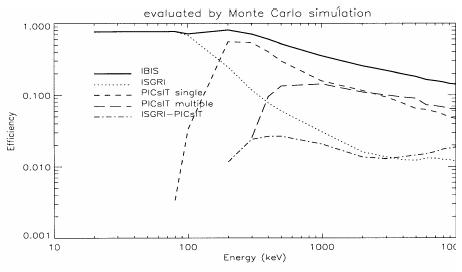 |
Both ISGRI and PICsIT record the coordinates of each event registered in the corresponding layer, to build up an image. The anticoincidence VETO is used to reject background events.
The coded mask produces a shadowgram. Photons from the source and the background are distributed across the entire field of view, but cross-correlation techniques allow the full image to be reconstituted for the fully coded field of view (9 9 ) at each pointing. For the partially coded field of view (out to 29 29 ), special cleaning techniques must be applied to the data to properly reconstruct the image. The actual sky coverage in an observation of course depends on the dither pattern.
The on-board electronics classify registered events according to the activated layer and the number of events detected by a submodule practically simultaneously. Events detected by different submodules are treated as independent ones. There are five main events type:
Photon is stopped in a single pixel of the ISGRI layer, generating an electric pulse.
In principle, the amplitude of the pulse yields the energy of the incident photon. However, above 50 keV the energy is a function of not just the pulse height but also the pulse rise time, so both are used to determine the energy of an incident photon. In addition, the resulting line profile (energy resolution) is no longer Gaussian, but more similar to a Lorentzian. The energy resolution depends on the operating temperature, and also on the bias voltage; the bias voltage has to be optimized as a trade-off between high resolution but more noise (high voltage) or lower noise but lower resolution (low voltage).
All cases of multiple ISGRI detection units excitation (in one module) are rejected. In case of the excitation of the detection units in different modules, such events are treated as independent single events.
Photon passes through ISGRI and is stopped in a single pixel of the PICsIT layer, generating one scintillation flash.
The energy of the incident photon is derived, in each crystal bar, from the intensity of the flash recorded in the photodiode. The energy resolution of PICsIT is a function of the signal-to-noise of the event, which in turn is governed by factors operating conditions and PIN capacity.
Several PICsIT detection units in one submodule were excited during one event, generating several scintillation flashes. The energy of the primary photon is determined from the sum of the energies of all detected events. The position of the incoming photon is attributed to the position of the most energetic event.
One ISGRI detection unit and several PICsIT detection units in one submodule were excited. As in previous cases the position of the incoming photon is attributed to the position of the most energetic event, and the energy is determined as the sum of the detected events energies.
In Fig.9 the efficiencies of the various detection techniques is shown.